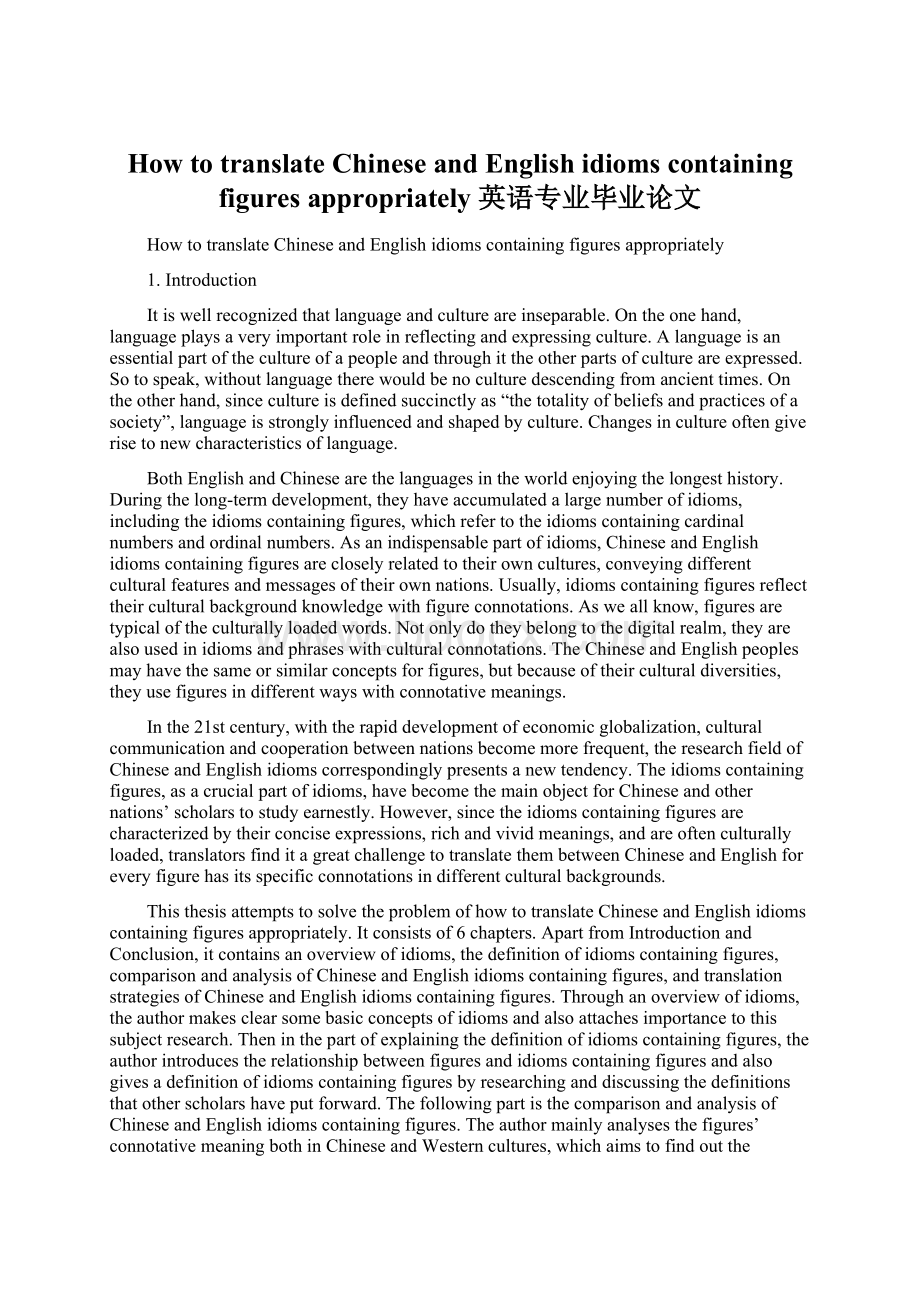How to translate Chinese and English idioms containing figures appropriately英语专业毕业论文.docx
《How to translate Chinese and English idioms containing figures appropriately英语专业毕业论文.docx》由会员分享,可在线阅读,更多相关《How to translate Chinese and English idioms containing figures appropriately英语专业毕业论文.docx(21页珍藏版)》请在冰豆网上搜索。

HowtotranslateChineseandEnglishidiomscontainingfiguresappropriately英语专业毕业论文
HowtotranslateChineseandEnglishidiomscontainingfiguresappropriately
1.Introduction
Itiswellrecognizedthatlanguageandcultureareinseparable.Ontheonehand,languageplaysaveryimportantroleinreflectingandexpressingculture.Alanguageisanessentialpartofthecultureofapeopleandthroughittheotherpartsofcultureareexpressed.Sotospeak,withoutlanguagetherewouldbenoculturedescendingfromancienttimes.Ontheotherhand,sincecultureisdefinedsuccinctlyas“thetotalityofbeliefsandpracticesofasociety”,languageisstronglyinfluencedandshapedbyculture.Changesincultureoftengiverisetonewcharacteristicsoflanguage.
BothEnglishandChinesearethelanguagesintheworldenjoyingthelongesthistory.Duringthelong-termdevelopment,theyhaveaccumulatedalargenumberofidioms,includingtheidiomscontainingfigures,whichrefertotheidiomscontainingcardinalnumbersandordinalnumbers.Asanindispensablepartofidioms,ChineseandEnglishidiomscontainingfiguresarecloselyrelatedtotheirowncultures,conveyingdifferentculturalfeaturesandmessagesoftheirownnations.Usually,idiomscontainingfiguresreflecttheirculturalbackgroundknowledgewithfigureconnotations.Asweallknow,figuresaretypicaloftheculturallyloadedwords.Notonlydotheybelongtothedigitalrealm,theyarealsousedinidiomsandphraseswithculturalconnotations.TheChineseandEnglishpeoplesmayhavethesameorsimilarconceptsforfigures,butbecauseoftheirculturaldiversities,theyusefiguresindifferentwayswithconnotativemeanings.
Inthe21stcentury,withtherapiddevelopmentofeconomicglobalization,culturalcommunicationandcooperationbetweennationsbecomemorefrequent,theresearchfieldofChineseandEnglishidiomscorrespondinglypresentsanewtendency.Theidiomscontainingfigures,asacrucialpartofidioms,havebecomethemainobjectforChineseandothernations’scholarstostudyearnestly.However,sincetheidiomscontainingfiguresarecharacterizedbytheirconciseexpressions,richandvividmeanings,andareoftenculturallyloaded,translatorsfinditagreatchallengetotranslatethembetweenChineseandEnglishforeveryfigurehasitsspecificconnotationsindifferentculturalbackgrounds.
ThisthesisattemptstosolvetheproblemofhowtotranslateChineseandEnglishidiomscontainingfiguresappropriately.Itconsistsof6chapters.ApartfromIntroductionandConclusion,itcontainsanoverviewofidioms,thedefinitionofidiomscontainingfigures,comparisonandanalysisofChineseandEnglishidiomscontainingfigures,andtranslationstrategiesofChineseandEnglishidiomscontainingfigures.Throughanoverviewofidioms,theauthormakesclearsomebasicconceptsofidiomsandalsoattachesimportancetothissubjectresearch.Theninthepartofexplainingthedefinitionofidiomscontainingfigures,theauthorintroducestherelationshipbetweenfiguresandidiomscontainingfiguresandalsogivesadefinitionofidiomscontainingfiguresbyresearchinganddiscussingthedefinitionsthatotherscholarshaveputforward.ThefollowingpartisthecomparisonandanalysisofChineseandEnglishidiomscontainingfigures.Theauthormainlyanalysesthefigures’connotativemeaningbothinChineseandWesterncultures,whichaimstofindouttheculturaldifferencesandmakeacomparisonbetweenChineseandEnglishidiomscontainingfigures.
TheanalysisandcomparisonwillbehelpfultoexplorethetranslationstrategiesofChineseandEnglishidiomscontainingfigures.Fortunately,theauthorfiguresoutsomestrategiesasthetheoreticalbasisofproblemsolving.Theauthorlistssomestrategiesandappliesthemtotheconcretetermsaccordingtotheirfeatures.Finally,bycomparingthedifferenttranslationstrategies,theauthorpresentshisownviewonthetranslationofChineseandEnglishidiomscontainingfiguresandofferssomeadvicetothelanguagelearners.Withtheguidanceoftheprincipleof“functionalequivalence,textualcorrespondence”,andtheauthor-and-reader-orientedprinciple,thetranslationofChineseandEnglishidiomscontainingfigureswilltakeonanewappearance.
2.AnOverviewofIdiom
“Idiomisagroupofwordsestablishedbyusageashavingameaningnotdeduciblefromthoseoftheindividualwords”,accordingtotheNewOxfordDictionaryofEnglish.Aspartofculture,idiomsplayanimportantroleinthedevelopmentoflanguage.Theycarryculturalfeatureandinformationofdifferentnations.Beingcharacterizedbytheirconciseexpressionsandsignificantmeanings,allidiomsderivefromtheirhistoricaloriginswithdistinctnationalfeaturesandarecloselyrelatedtogeographicalenvironment,historicalbackground,religiousbeliefs,socialcustomsandlivingconventions.Sotranslatorsshouldtaketheirculturalconnotationsandnationalcharacteristicsintoconsiderationwhentranslatingidioms.
2.1.TheHistoricalStudyofIdiom
Generallyspeaking,thestudyofidiomcanbedividedintothreestages.Asearlyasin1925,L.P.SmithpublishedthebooknamedWordsandIdioms,whichisregardedasthebeginningofidiomsresearch.Inthisbook,Smithdiscussedthesourcesandstructuresofidioms,andpointedoutthebasiccharacteristicsofidioms:
anidiomcanbedefinedasagroupofwordswithameaningofitsownthatisdifferentfromthemeaningsofeachseparatewordsputtogether.Hewrote,“Themeaningofanidiomisnon-literal;manyEnglishidiomsareusedas‘expressionsofdetermination,ofexasperation,andvituperation’,whichcontributestovocabularystudiesasbeingadescriptionofhowthepeculiargeniusofEnglishshowsitselfinitsidioms”.Besides,agoodpartofSmith’saccountofidiomsisdevotedtotheirclassificationonthebasisoftheirimagery.Fromthe1930sto1950s,onthebasisofStructuralismTheory,C.F.Hockettemphasizedtheimportanceofcontextunderstandingintheidioms’identificationandinterpretation,andexplainedtheunderlyingstructureandsemanticfeaturesofidioms,whichbegantostandardizethedefinitionofidioms.In1960s,influencedbytheGenerativeGrammarTheoryofChomsky,thestudyofidiomsreachedanimpasse,butneverstopped.NotuntilB.Fraser,arepresentativelinguists,putforwardtheFrozennessHierarchyTheory,inwhichheadmittedthatidiomsareinfixedexpressiondidthistendencyfinditsoutlet,butB.Fraserthoughttherestillexiststransformationalpotential.Thus,thestudyofidiomscameintopublicnoticeagain.Sincethe1980s,thestudyofidiomshasenteredanewstage.Linguistsbegintoopenupthefunctionalapproachofidiomsinrelationsenvironment,exploringtherolethatidiomsplayincommunicationactivities,whichmakesthestudyofidiomsmorepractical.Amongalltheachievements,themostprominentonebelongstoC.Fernando’s,anAustralianlinguist,whowrotethebooknamedIdiomsandIdiomaticity.Inrecentyears,agrowingnumberofscholarshavebeguntostudytheformationofidiomsfromtheperspectiveofculturalbackgrounds.Nida(1993)everwrote,“Cultureknowledgehasafar-reachingimpactonthestudyofidiomsandtheirmeanings.Wewillfailtounderstandtheprofoundmeaningofidiomsifwedon’ttaketheculturalbackgroundsseriously”.Therefore,wemustfocusonitsculturalconnotationswhilelearningalanguage.
2.2.TheStructureandFeaturesofIdiom
Idiomsareofspeciallanguageforms.Theyhaveasinglesemanticunit,structuralinstitutionalizationandirreplaceability.MorespecificallyelaboratedbyMcMordie,“Generally,theidiomcannotbechangedatwill;anywordintheidiomcannotbereplacedbyitssynonyms,andlittledoesthewordordercanbechanged;anychangeinthewordingandcollocationwilldestroytheidiom,ormaymakeitnosense”.FromMcMordie’spointofview,wecanseethatanidiomhasitsownstructuralandsemanticfeatures.
Idiomsarecharacterizedbytheirstructuralstability.Anidiom,composedofagroupofwords,isasetphrase.Thestructureofanidiomisalwaysfixed,andthewordsinitcannotbedepartedorseparatedatwill.Becauseofitsstructuralinvariability,anidiomallowsnovariationinformundernormalcircumstances.Aspeakerorwritercannotnormallydoanyofthefollowingwithanidiom:
1.changetheorderofthewordsinit,(e.g.*‘theshortandthelongofit’);2.deleteawordfromit(e.g.*‘spillbeans’);3.addawordtoit(e.g.*‘theverylongandshortofit’;*‘facetheclassicalmusic’);4.replaceawordwithanother(e.g.*‘thetallandtheshortofit’;*‘buryahatchet’);5.changeitsgrammaticalstructure(e.g.*‘themusicwasfaced’).Allidiomsarenotgrammaticallyregular.Therefore,theidiom“facethemusic”cannotbechangedinto“themusicwasfaced”,whichhaschangeditsgrammaticalstructure.
Semanticunityisanotherfeatureofidioms.Themeaningofanidiomisacompleteandinseparableunit,whichshouldbelearnedasawhole.Thatistosay,anidiomcanbedefinedasagroupofwordswithameaningofitsownthatisdifferentfromthemeaningsofeachseparatewordsputtogether.Thesemanticunityofanidiomderivesfromthetransferredmeaning,whichreferstothefigurativemeaningandassociativemeaning.Nowthatmostfigurativemeaningandassociativemeaningofanidiomarenottransparent,andsomeevenlosetheinitialmeaningofthewords,aspeakerorwritercannotgetthemeaningofanidiomjustfromthemeaningofeachwordinit.
Thestructuralstabilityandsemanticunityarethemostimportantfeaturesofidioms,bothofwhichcanbetakenasidiomaticity.Thisisthebasi